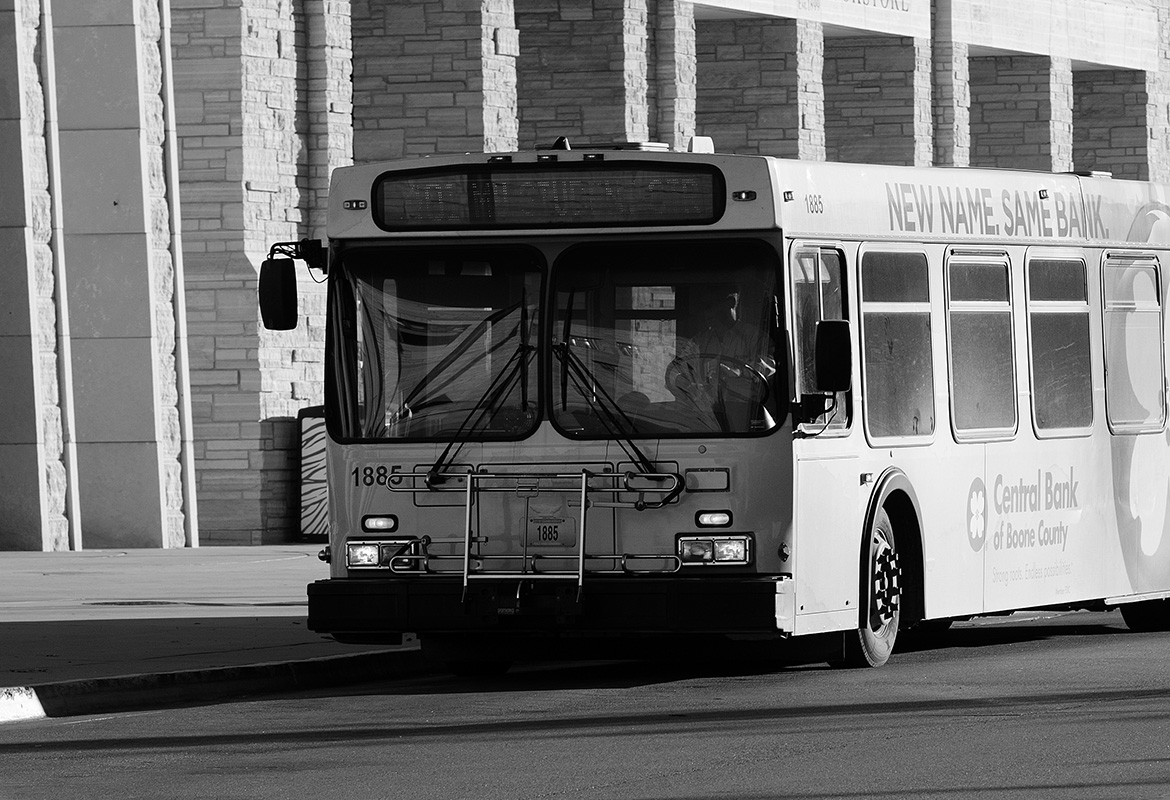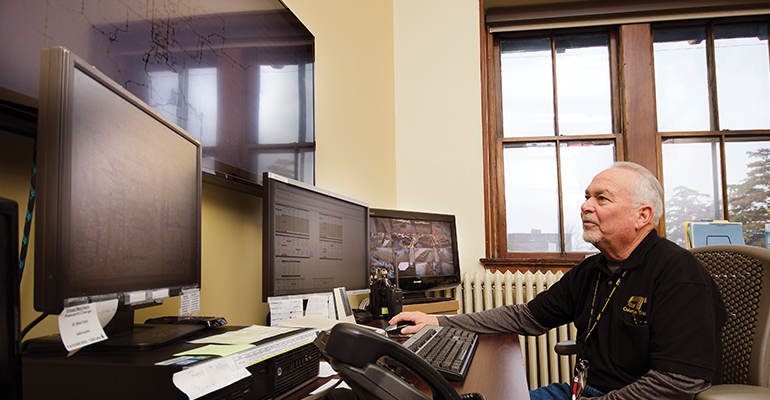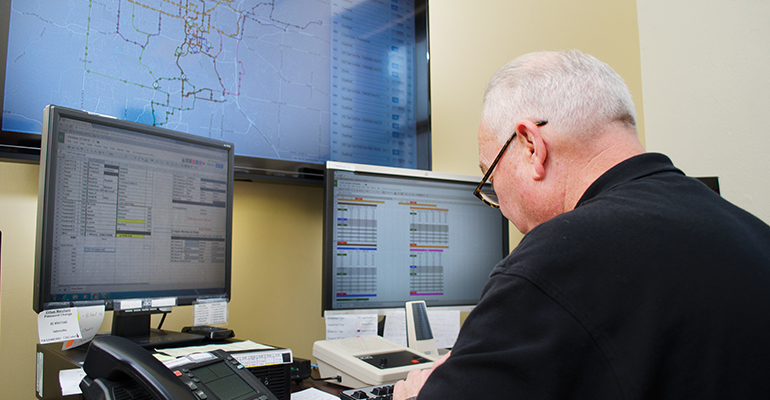Route Review

More than a year into a strategic rerouting of the bus system, is Columbia better served by COMO Connect?
Like so many other fall mornings, this one was bright and mildly chilly. It was just after eight, and I stood in the shadow of the three-story office and retail building at Kelly Plaza, on the corner of Providence and Vandiver, as I waited for the bus.
The shuffle of traffic and a dull wind occupied mostly empty parking lots around me. Many businesses hadn’t opened yet, and many employees were on their way to work. My bus, a 40-footer, rumbled over a hill and through the intersection. The wind shifted through the sweet, noxious smell of diesel.
Today, this bus was servicing route 1B, a Black Connector route, which roughly bisects Columbia north-to-south. When the city reorganized its bus routes in August 2014, this became one of two key connector routes, designed to transfer riders from exterior neighborhoods through the city’s interior corridor. To get anywhere far on COMO Connect, you have to take either the Black or the Gold Connector.
Nobody else was on my bus. My quarters jammed in the change receiver. The driver explained the machine was broken; he flipped a switch behind the change box and said I could sit down.
His name was Charles Lipham, but he goes by Beau. He’s been driving for five years, and as such, he was part of the transition from Columbia Transit, the system’s former name, to COMO Connect — a rebranding and redesign of the bus routes, but also a strategy shift, indicative of greater changes in the city.
Beau never stood during my time with him, but his sitting figure seemed tall. He wears wire-frame glasses and has elaborate tattoos inked all over his arms and legs, and a small blue star tattooed below his right ear (I never saw his left ear).
“I bounced around between town routes and campus routes, so I saw both sides, which a lot of people don’t see,” Beau said. He also rides the bus, with his wife and kids; like many bus riders, they don’t have a car. They use the Gold Connector to get about anywhere they need to go.
I asked Beau how the work had changed since new routes began. We were heading south now, toward downtown.
“The changes aren’t just in the routes,” he said. “The city, the council is finally letting us do things the way we want to do them.
“And that’s helped?” I asked.
“It’s just a much better place to work.”
Before COMO Connect, the bus system used a web-like central hub method. All the buses congregated at one place, Wabash Station, picked up passengers and then shuttled them out all over the city. Then the buses came back.
Wabash Station was originally built as a train depot for the Wabash Railroad. The building — a small, tan Victorian-inspired place, with plenty of open space around it — went up in 1910. The Wabash line fizzled in the 1960s, and when the city bought the station in 1979, it had been unused for nearly a decade.
Today, Wabash Station occupies a central space in the North Village Arts District, Columbia’s eclectic neighborhood on the edge of downtown. The station shares a parking lot with, among others, an organic grocer, art studios and a coffee shop that used to be a garage. A comic store, breakfast nooks, a community theater, art galleries and loft apartments are all within a block.
The building’s location, right in the middle of the city, used to be its biggest strength, but Columbia has grown out and up since Wabash Station was built. The middle of the city became harder to get to, and buses were getting caught in traffic. COMO Connect’s routes ensure that riders can now avoid ever going near Wabash Station at all.
But COMO Connect still headquarters there, and thanks to an FTA-funded $2.37 million renovation in 2007, the building is in good shape. It’s where I met Drew Brooks, the city’s transit manager.
His official title is multi-modal manager, and Brooks now oversees Columbia Regional Airport as well as COMO Connect, but he started with the buses; from 2008 to 2013, he was the city’s transit superintendent. On workdays, he bounces between Wabash and his office at city hall, a few blocks away. After we met in the station’s lobby, we sat down at a circular table in the office of Dale Lynn, Brooks’ successor as superintendent.
Like Beau Lipham, Brooks is a man of impressive facial hair — thick goatee with a just-slightly-twirled mustache. He speaks with compulsive confidence, and I was surprised by how he characterized COMO Connect’s first year.
“It’s inconclusive at this time,” Brooks said. “Our overall ridership has been up, but that’s including the university routes we run. And we actually knew our ridership would dip a little bit.”
Ridership grew until 2012, but Brooks said it’s been mostly declining since then. During August 2014, the city reported drastic year-to-year growth —65,925 to 77,236 — but that was propped up with the free fares temporarily installed to draw riders to the new system. In the following months, ridership fell back down.
The initial dip was somewhat by design. The city wanted to make routes more efficient, with fewer transfers, which meant fewer rides. It was a response to the turbulence the department came through in previous years: in the mid-2000s, around the same time Brooks came on as superintendent, student housing developments began popping up on the south side of town. For a while, it wasn’t a problem. The city made some accommodating changes, and ridership spiked as Columbia Transit began contracting with some of the complexes. But resources began to wane; the buses were traveling further and required more care and attention. Transit, like many other departments, began dipping into reserves. Brooks and company made route adjustments, started selling more advertising on the buses and increased fares (which, incidentally, lowered ridership further), but the need for a substantial change became more apparent. The city began a reconstruction of the bus system, and internally named it COMO Connect.
Another passenger joined me on Route 1B at Business Loop and Rangeline. She spoke politely to Beau as she got on, took a seat near the front and put her headphones in. Her name was Waana Kaluwasha; she had excellent posture. Kaluwasha is a first-year grad student at MU. In August, she moved from her native Zambia to an apartment off Business Loop. She rides the bus to class everyday.
“Do you see many people on the bus?” I asked her.
“Very few,” she said. “Less than 10. Sometimes less than five.”
Another woman had gotten on at the stop after Waana’s, and two more joined on the subsequent three stops. Waana got off at the MU Student Center, and a waiting student came aboard to take her place. After Beau maneuvered the bus through a crowded campus, we headed south.
Student housing was the real budget buster for us,” Brooks said. MU’s enrollment growth brought in population and development, and for a time, it brought in demand for the bus system too. But traffic worsened; and an already strained bus system continued to struggle.
Still, students kept coming in, so development kept going up, and apartment complexes kept contracting with Columbia Transit — but with seasonal ridership. “Everything changes with students,” Brooks said. Students change the success of different routes, students change the revenue brought in.
Ultimately, Columbia Transit was unable to find a successful strategy to service the new developments, and many began to contract with independent shuttle companies. It was yet another blow to the system — routes around the complexes still existed, but now they had fewer paying passengers. When Brooks was promoted to multi-modal manager in 2013, Columbia Transit as it had been known since the early ’80s was taking its last breaths.
“It was a very good system for a small city,” Brooks said. “Columbia just isn’t a small city anymore.”
While redesigning the bus system, the COMO Connect team made public participation a priority. Officials realized that, for most riders, the bus was a last resort, not a convenience: very few people with other means of transportation were riding the bus. COMO Connect wanted to hear from those not riding.
They held multiple public meetings in each ward, and they worked with suggestions from city council and from the Public Transit Advisory Board, a group specifically designed to represent diverse interests in the community. Brooks characterized the process as “the most extensive public participation project the city has ever done.”
But the public dialogue failed to reach some riders, who hadn’t been to the meetings or read the articles or seen the signs announcing COMO Connect’s new routes. On the first day with the new routes, Brooks was among his employees in Wabash Station, scrambling to answer phone calls from people asking where their buses were.
I asked Brooks what public opinion was like after a year. He let out a short sigh and said: “It’s been mixed. There have been some growing pains, without a doubt, but we’ve had a really enthusiastic response from a lot of people. I think if you look on the street, you’re going to see more people out there riding the bus.”
To mature through the growing pains, Public Works asked the city to hire a transportation consultant: Olsson and Associates, a Kansas City firm with a good track record in college towns. The consultation, as stipulated in a council meeting, would cost between $100,000 and $250,000 dollars from the department’s transportation sales tax.
It would be a return to roots: when Columbia began operating the bus system in 1965, after the unexpected closure of the privately owned Columbia Municipal Bus Line, the city brought in help from the Bi-State Development Agency, then in charge of the bus system in St. Louis. Bi-State helped design the routes, train the employees and threw in some temporary buses to bolster the fleet.
In preparation for Olsson and Associates, who will likely begin after the first of the year, COMO Connect has been gathering data. Using GPS-enabled sensors installed at each bus entrance, the city is creating a map of “hot zones,” as Brooks describes them — a map to indicate which routes are successful and which aren’t.
Between September 2014 and September 2015, ridership has stayed consistent: most 2015 neighborhood routes stayed within 1,000 riders of 2014 numbers, except for the Brown route, which has fallen off. The Black and Gold Connectors have the least consistent ridership numbers, but also, naturally, are the most ridden; the Dark Green and Light Green routes, which serve the south and southwest edges of Columbia, have been the least ridden.
Brooks mentioned that, when COMO Connect began, council requested that a Gold route be moved closer to the MU Student Center, which was a good idea in theory, but didn’t work — the route couldn’t stay on time. COMO Connect tweaked six problematic routes in November 2014, and two more the following February. They’re hoping the consultant can provide a comprehensive, final analysis of the entire route design, eliminating the need for continuing changes.
“I think we’re really good at running a transit system,” Brooks said, “But none of us are transit planners. That’s not our bread and butter.”
Dwayne Grubbs lives near downtown, but he works down south, at Hoss’s Market. Every workday, he rides his bike to a stop along College Avenue and puts his bike on the front of the Black Connector bus, which he rides to Providence Road and Green Meadows Parkway. There, he gets out and bikes the rest of the way to work, about a mile and a half. When I met Grubbs, he was wearing glasses and a black baseball cap with The Beatles logo on the front. He sat across from me on the bus.
Grubbs lives within a five-minute bike ride from Wabash Station, so the route changes were a minor annoyance for him.
“There are a lot of people who have been riding for a long time who think it’s catering more toward students,” Grubbs said. “And they don’t really need it, but there are a lot of them.” I asked him if the city was doing a good job handling the system. He nodded and said, “I think they’re doing their best.”
Our bus picked up more people on the south side of town, including a handful from Gateway at Columbia, a student apartment complex near Nifong and Providence. Most of the other passengers we picked up were students as well, though they didn’t come en masse — just a couple from each stop, dotted all over the neighborhoods around Nifong and Grindstone Parkway.
As we were driving through these neighborhoods, I asked Beau if he ever had safety trouble with passengers. He laughed.
“It happens,” he said. “But the vast, vast majority of people who get on the bus are great and polite.” But still, he told me, he’d been threatened and cussed out, and he’s called police to his bus twice.
“When you’re dealing with the general public, and they’re agitated because they don’t have a car, and you stick them in a metal tube, it happens,” he said. “Especially in the summer.”
Beau encounters more incidents on the Gold Connector than the Black; indeed, most of our passengers seemed docile. Around half were listening to music, and some others were talking quietly with a friend. The young man sitting next to me was just placidly looking out a window. His name was Jared Melton, a sharp-chinned junior majoring in computer science. His apartment complex doesn’t have a shuttle, so he rides the bus, which is mostly fine with him. He said it occasionally runs a little late, but it’s usually no big deal.
Our ridership peaked at 14, including me. 11 got off when the bus returned to the MU Student Center.
As chair of the Public Transit Advisory Board, Cheryl Price has tried to bring Columbia’s student population into the bus system’s fold. Price rounded out the 13-member commission with representatives from MU, Columbia College and Stephens College, and she meets with the Missouri Students Association, which she says has led a refreshing renewal of student interest in public transit.
I met Price in her driveway. She was tired from speaking at a council meeting the night before and didn’t want to leave the house, but her husband, who works nights, was sleeping inside, and she didn’t want to wake him with our conversation. Price told me all of this twice — once over email and again in person. She’s sometimes forgetful, one of the lingering effects of a traumatic brain injury. In 1980, while working as a nurse at the VA, Price slipped on a discarded set of scrubs in the locker room and hit her head. It took her about three years to relearn talking and walking, and since her accident, Price has devoted her time to public service. In recent years, she’s focused her energy on the PTAC.
Price was excited about a lot of things. Council had just approved funding for a series of new bus shelters, and they had preliminarily approved funding for the consultant ($161,000, she told me, “very, very low”). The city’s first electric bus was due to arrive in a few weeks, a significant step toward the half-electric fleet that Brooks envisions. Price was among those to test-ride the electric bus last spring. “We’ve received only positive, complimentary responses so far,” she said.
Her breezy enthusiasm speaks to the organizational relationship COMO Connect has cultivated between the city and its community advisors. Price meets consistently with Brooks, whom she calls “a fantastic director and an excellent staff person.” She feels the commission’s suggestions hold weight with council — the bus shelter approval came after her remarks on the importance of “safe and comfortable shelters” for everyone.
Price thinks the COMO Connect project was an appropriate move, but a difficult one. “Once the consultant arrives, we’re going to have to try a very vibrant outreach program,” she said. “One thing that is very important to me is different ways of public response to transportation.” She paused to laugh. “Because the community meetings didn’t work, obviously.”
Columbia, she said, is a difficult city to cover with public transportation — wide and spread out in some places, dense and narrow in others. She hopes the consultant can provide clarity to the logistics of a citywide bus line. Price said, “We have to decide whether we’re going to continue to serve the entire city or if we’ll have to go with a lean and mean system where, unfortunately, some routes get cut.”
I asked Brooks what he envisioned in a COMO Connect utopia: if he could have everything he wanted in his bus system, what would it look like?
“Well,” he said, “I think we would have a service where a bus is passing a stop every 10 minutes, so you don’t have to think about the schedule. I think that if you get to that point, where you have a really efficient, convenient service for people, I think that’s the tipping point. If we could figure that out — whether that’s a funding model or a restructuring or whatever that is — I think that’s the utopia.”
Toward the end of our route, when it was once again just the two of us, I learned that Beau was perhaps overqualified to drive a bus. He had been stationed in South Korea while in the Army, 2nd infantry, where he captained Blackhawk teams and tank crews before his knees deteriorated too much to board and jump off the vehicles multiple times per day.
Beau, like Price, admires Brooks as a leader. He feels that he and other drivers hold some sway in the department’s operations, and he thinks they’re on the right track.
We arrived back at Kelly Plaza, and I got off. The parking lots were fuller now, and it was warmer. I checked the time, and we had come back ahead of schedule.





